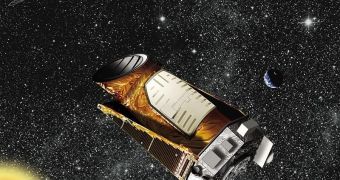Scientists at NASA are currently analyzing the possibility of bringing the agency's Kepler Space Telescope back to life, after the spacecraft's original mission was forced to conclude due to an error earlier this year. The new mission would focus on hunting for planets located around stars in the plane of our planet's orbit.
Kepler was the first-ever space telescope dedicated to finding extrasolar planets in a tiny portion of the Milky Way sky. Since March 2009, it discovered more than 3,500 potential candidates, of which a handful exhibit characteristics closely resembling Earth's own. Finding worlds similar to our own was the mission's main objective.
The telescope was forced to conclude its main mission ahead of schedule following an error that occurred in May, when the second of four reaction wheels aboard the spacecraft failed. These instruments were used to maintain its orientation, so that it always focused on a single patch of sky.
With only two functional reaction wheels, Kepler can still be used for science, but there are now more limits to what it can do. This is why the proposed K2 mission will focus on searching for exoplanets that orbit small stars in the plane of Earth's orbit, Space reports.
With K2, “we expect to find dozens, or maybe even hundreds, of such planets,” explains the principal investigator of the Kepler mission, Bill Borucki. The expert is based at the NASA Ames Research Center (ARC), in Moffett Field, California.
“If we're looking at smaller stars at shorter [orbital] periods, we may find, in fact, many of those are also in the habitable zone,” he adds. The habitable, or Goldilocks, zone around a star is the area where temperatures are just right to support the existence of liquid water on an exoplanet.
Of the 3,500 worlds, Kepler discovered to date, more than 160 have already been confirmed through follow-up observations by ground- or space-based telescopes. NASA experts believe that up to 90 percent of all candidates the telescope identified will eventually be confirmed.
If the K2 (Kepler-2) proposal is accepted, then the satellite will survey an area of the sky 5 to 10 times larger than its original target. Scientists believe that the spacecraft will be able to survey between four and six new fields of view per day, at a density of about 10,000 to 20,000 target stars per field.
In addition to looking for exoplanets, Kepler could also focus its second mission on studying supernovae, star formation patterns, and on detecting asteroids and meteorites closer to home. NASA is expected to make a final decision about K2 by the middle of 2014.

 14 DAY TRIAL //
14 DAY TRIAL //